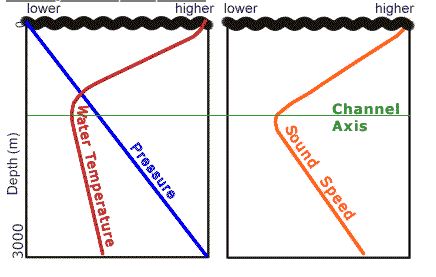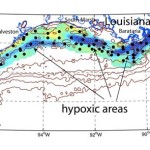Sound in the ocean does not behave like sound in the air. This is also what makes sound in the ocean so awesome. Sound in water is like the cool funky uncle of the sound family. It travels ridiculously fast, nearly 5 times faster in water than in air. It also does not travel in a straight line, but in very curvy paths which are caused by changes in sound speed.
There are two things that cause sound to change speed in the ocean, water temperature and pressure. Increase pressure and temperature, then you also get an increase in sound speed. In an imaginary ocean of constant temperature and beautiful unicorns, sound speed will be small at the surface and large in the abyss as pressure increases with depth. But in the real ocean where there are no unicorns (unless you count narwhals), temperature decreases with depth. Thus temperature has the opposite effect of pressure, causing sound speed to decrease with depth. At the surface, the ocean is so warm its effect on sound speed totally obliterates the effect of pressure, causing sound speeds to be large. But pressure is patiently waiting for its chance to shine. As temperature decreases with depth, pressure slowly increases. Eventually the effect of pressure will be so great, that it will emerge victorious, causing sound speeds to start to increase! Since ocean temperatures bottom out at -2C and pressure keeps on increasing in the deep ocean pressure will always win out. This causes the speed of sound to increase all the way to the bottom of the ocean.
This epic battle between pressure and temperature causes a sound speed minimum around 1 km deep in the ocean at mid-latitudes (the depth of the minimum does change as ocean temperature profiles change with latitude). The sound speed minimum also has an awesome secret. It helps trap sound. While it may sound nefarious, this is a very good thing.
Generally, sound waves travel away from their source in concentric rings, aka radially. Sounds that are generated near the sound speed minimum will spread upwards and downwards into regions of larger sound speed. The increase in sound speed causes these sound waves to be bent back in the opposite direction. Now turned, the sound wave will try to escape the sound speed minimum again. But having turned, the sound wave propagates past the sound minimum back into a region of higher sound speed, causing the wave to be turned yet again. This happens over and over to the sound wave, passing the minimum and being turned back around, trapping the oscillating sound waves in a narrow vertical band. This band is what ocean acousticians call the SOFAR channel (My acoustician friend tells me the channel isn’t really a channel, because as you can see below how far up and down the wave oscillates changes depending on the initial angle of the sound wave. But I think it’s a name helps you to imagine how sound gets trapped there).

SOFAR stands for SOund Fixing And Ranging. Because sound waves are concentrated and trapped within the SOFAR channel with very little loss of power, they can travel very far. But why the name SOFAR? Scientists initially verified the existence of the sound channel in 1943 by bombing the crap out if it. Well not literally. But they did detonate a whole bunch of underwater explosives at different depths and distances and listening for them from very far away (about 3200 kilometers). Using an array of hydrophones (underwater microphones) and some complex trigonometry, they could locate these and other detonations, thus the fixing and ranging. They were able to locate these sounds so accurately that the Navy wanted to use the SOFAR channel as a type of location system (this was WAY before GPS people) to rescue downed fighter pilots in the ocean. The idea was that a plane that was about to crash would drop a small depth charge which would detonate within the SOFAR channel. Then the Navy could locate the sound, send out a boat, rescue the pilots and everyone would rejoice. HUZZAH, Camparis on the poop deck!
But don’t give scientists all the credit for discovering the SOFAR channel, whales have know about it long before we humans did. Scientists think that humpback and other whales use the SOFAR channel to communicate over long distances as they migrate. I wonder if their calls get dropped too?
I mentioned that scientists verified the existence of the SOFAR channel in 1943, but in 1991 scientists did something even more crazy than dropping bombs off boats, they wanted to test the limits of sound propagation in the SOFAR channel. The idea was to make a hell of a lot of noise in a remote location and figure out how far away they could hear it. 
- Heard island was the location of a giant acoustics experiment to determine how far sound could travel in the ocean. The path of sound waves to different sources are illustrated above.
First step, find an appropriate remote location. Heard Island in the Southern Ocean fit the bill. Sound generated there could reach both the east and west coast of the US. Then they sent a ship down there to make a racket. But instead of bombs, they used what is essentially a giant subwoofer. Bombs make a lot of noise, but it is hard to measure exactly how much noise they really make. With the ocean subwoofer, they could know exactly how loud the sound they made was. This helped scientists how much energy the sound wave lost when it was eventually heard thousands of miles away.
The cruise was fraught with some problems (sources dying, typical crazy Southern Ocean weather), but they were able to complete the experiment. Sound travelled over 10,000 kilometers, reaching the both US coasts somewhere around 3 hours after they were generated. The scientists also found that currents and water temperature affect sounds path and velocity, starting the oceanographic subdiscipline of acoustic thermometry, measuring the ocean temperature with sound. It was even proposed that you could conduct more experiments with sound and use acoustic thermometry to determine how much the ocean was warming due to climate change! You can read more about the Heard Island experiment here, or read the ship’s tongue-in-cheek daily log . I love that silliness and oceanography have always been intertwined!

Lastly, while we know that bombs and whales and boats all cause sounds in the ocean, there are other sounds. Inexplicable sounds. Sounds that drive conspiracy theorists into a tizzy.
One of these sounds is “the Bloop.” You can listen to the creepy, creepy sound of the Bloop on youtube. No one really knows what caused the Bloop, but it was recorded in 1997 and originated at 50S in the South Pacific near South America. The Bloop is too loud to be caused by any known animal, but it resembles sounds made by other animals rather than other natural phenomena such as earthquakes or ice movement. Therefore, in the great tradition of wild speculation, I present another explanation.
Clearly, the Bloop can only be the song of the great undersea creature known as the Kraken.







Great post! Not to be pedantic (pedantic? me?) but I feel obliged to point out that sound speed in water also depends on salinity and pH. Not as strongly as on temperature and pressure, but still enough to matter to those of us misguided enough to use sound to try to locate fish and plankton…
Excellent post! It is always amazing to me to run across something like this. It seems so obvious (now!)that temp and pressure would have an effect on sound in the sea but I have never read anything about it. I love Deep Sea News – keep these posts coming!
Thank you for such an interesting post (love the graphics and humour)! Deep Sea News is my favourite info source.